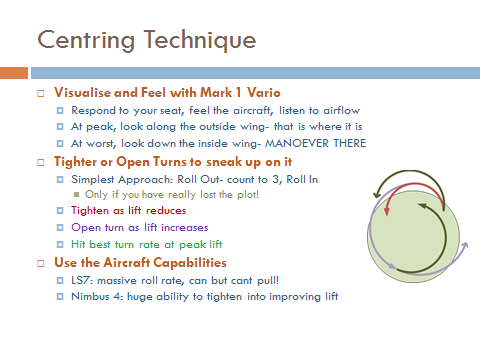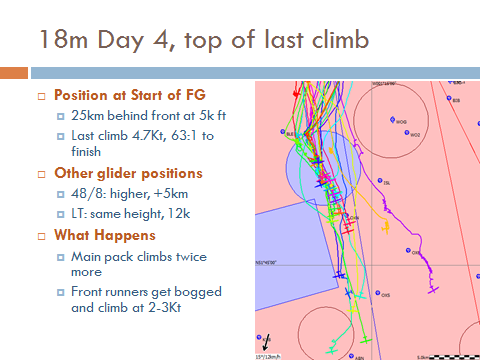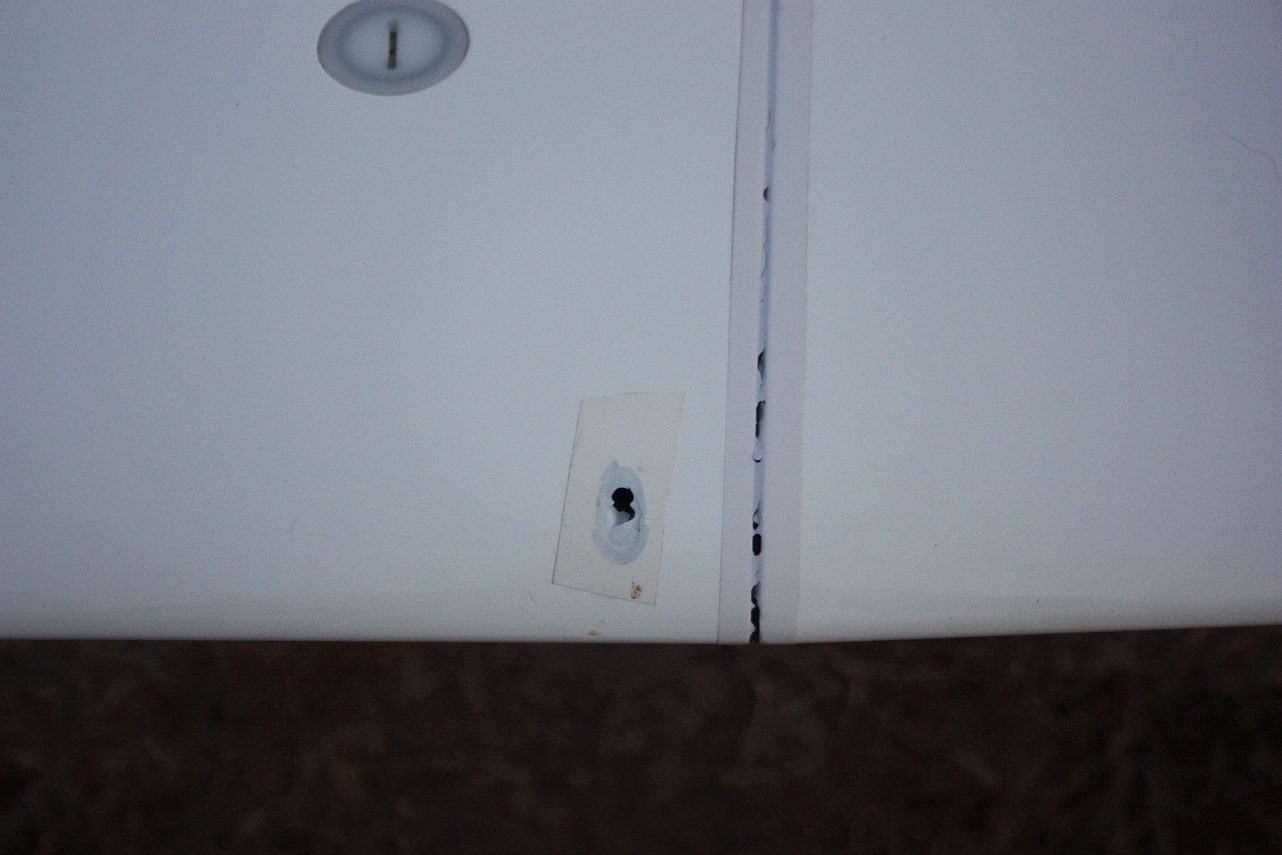Engineered Systems LtdProgramme and Project Management by Ed Johnston |
Mobile +44 (0)7860 663886 |
Coaching 2013/14
This page has the materials worked through at the LGC coaching sessions with Matt Cook and Ed Johnston
Our Mission: To add 10kph to cross country speed for committed attendees
Dates and Subjects, Flight Analysis:
Sessions held at 7.30 pm in the Withall Briefing Room, Dunstable Airfield. Pizza orders from 7pm.
You can look through flight analysis and conclusions here:
|
|
Introduction
The coaching sessions are all about discussing tactics, technique and theory in an informal setting
The tools we are use are discussions on specific points of interest and walk through of real flights, recalling what went well and what could be improved
Take a look through the slides we talked through on 14th November:
How fast can you go? This spread sheet lets you do the What If game.
Take a flight and use the basic stats of average speed and glide angle in the straight, average climb rate and plug in the numbers
Then think about which of those things you could have done better- see what difference it might have made.
Start Times and Turn Points
Planning for the Start
So you have sat through the briefing, drawn up the task- what do you do next?
How to think through the task, make your plans and then refine or revise them right up to starting time.
Rounding TPs Efficiently

We all know that you should go high into downwind turns, or get round then climb after an into wind TP. This spread sheet shows just how much time you can save or lose by climbing before or after a TP.
PS- can anyone spot the mathematical simplification?
Some Flights to Analyse
Many thanks to Steve Lynn for his flight on 2nd June, and the boys on Day 4 of the Dunstable Regionals last year.
Technique in the Glide
This session concentrated more on how to work efficiently in a straight line, whether flying in competition or club flying.
Key take outs were to focus on three levels:

- The Here and Now: Working the air that you are in or right next to
- Tactical Planning: How to get through the air as far as you can see
- Whole Flight: Being aware and planning for turn points and getting onto Final Glide
Conclusions and Tips
Stretching the glide has multiple benefits: keeps you away from the ground, allows you to sample more thermals, spend proportionally less time in the climb
But it is not always the best thing to do: If the next climb is certainly good, pile on the coals! You cant beat a really strong thermal at the right time.
Ideas to work on:
- Determination to not turn your back to track
- Keep the speed on before you hit lift
- Get the speed on before you hit sink
- Micro-Routing within an area of lift- observe and learn!

Technique in the Climb
Methods for selecting climbs, making best use of then leaving them efficiently is pivotal so efficient, fast flying.
We cover getting to know your glider; the need to experiment, find the boundaries, then practice being close to the limit without risking getting over it, even if you fall out the side. The target: get tight and slow without entering the drag bucket.
Then look through the phases of thermalling
- Entry: Take your time, feel the air, be sure before you commit to the full turn
- Centring: Know where the centre is and manoever smoothly into it, using best features of your glider
- Exiting: Plan ahead, choose the line then get the speed on before hitting the sink

Final Glides
What can be gained on a final glide, firstly by getting your brain into Final Glide Mode early: at least one full climb short of being on Final Glide.
On a good day, bouncing up the energy can make a huge jump. One example when G9 made up at least 10Km and up to 25Km on the final glide,
However we all know final glides can go wrong, so make sure you don't lose more than you gain. Make sure you can make it safe before you get to 2000AGL, one way or the other. If it is going wrong, stop and climb early rather than at 800ft!
Follow the golden rules of final gliding both to stay safe, but also to get back efficiently
- Be Prepared: scope the site for fields before leaving the site
- Never set the Speed to Fly above 4Kt
- Make it safe at 2000ft above site (500 in hand, decent ring setting)
- Keep bigger margins on down-wind final glides
- Plan your finish 5 minutes out

Competition Psychology
Easy enough to fill an entire series on this subject, so here we just do a quick skim over the surface.
What works for one person wont work for another. So rather than teaching how to think, we try and learn what the outcome feels like, then find ways to get there.
In discussion there are lots of ways to get there, through visualisation, planning, preparation or plain lack of imagination. Whatever works for you.
However the key is to talk about experience, how it worked (or didn't) then let the thought, question and ideas flow on how to deal with that situation yourself.
So to get going yourself:
- Buy your tame pundit a beer
- Talk through your experiences, quiz them on theirs
- Get yourself where you are not going too cautious too soon
- Make sure you respond to trouble ahead before you hit it
- And buy you tame pundit another beer!

Difficult Days
Talking about difficult days, not just slow days.
Simply slow days can sometimes be a good, simple test of pilot efficiency through the air. What makes a day difficult is the number and difficulty of key decisions the pilot has to make. In particular the decisions which make a big difference at the end of the day yet are very difficult to get right at the time.
Blue days are often difficult, as weak days or low days. Sometimes you can get the Holy Trinity- all three together!!
However, blue days can be straight forward, weak days just require patience, low days often have thermals closely spaced and easy to find.
Difficult days are about how you make decisions with limited information and live with the consequences.
Take your time and you will get more big decisions right. Accept the fact that you wont simply have it all your own way, but neither will anyone else.
The main thing is state of mind: Stay Positive and its amazing how well things work out!

Long Days
Best way to do a long distance is to fly fast!
None of this messing about, surviving for the duration of a long day, extending your local soaring until the day runs out. Start positive and get faster as the day goes on and hopefully, final glide home off the last thermal of the day.
Of course, to get there you first have to be prepared to fly a long day, take the risks associated with starting early with a heavy glider on a good day.
The rewards can be great:- the satisfaction of making the very most of a long day's flying, which must include going as fast as practically possible in the heart of the day.
And knowing that you have used the day, not just the best bit in the middle that those in the bar are discussing as you climb up to your final glide...
Well that is the story if it all goes well! :-)

Showery Days
Another minor subject for the day: how to cope with showery conditions, making the most of these conditions, best chances of getting round, through or past them while being mindful of the danger that some big showers can pose.
In the UK, showers are rarely very bad, but the rain, occasionally hail, can get bad enough to be dangerous. This picture though, is what a proper Texas storm can do: big handful sized clumps of soft hail battering the tape to ribons, not to say making an impressive din on the carbon-fibre timpany. Also had to close the vent after getting a couple of icy showers through the noze vent!



